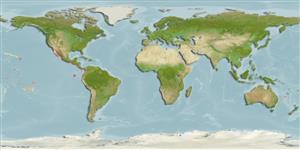Environment: milieu / climate zone / depth range / distribution range
Ökologie
seewasser riff-verbunden; tiefenbereich 3 - 68 m (Ref. 5227). Tropical
Eastern Pacific: Baja California to Peru, including the Galapagos and other offshore islands.
Size / Gewicht / Alter
Maturity: Lm ? range ? - ? cm
Max length : 28.0 cm TL Männchen/unbestimmt; (Ref. 5227)
Rückenflossenstacheln (insgesamt): 3; Rückenflossenweichstrahlen (insgesamt): 23-26; Afterflossenweichstrahlen: 16 - 18; Wirbelzahl: 24. Sides of body, excluding cheeks, mottled with cream to pale-brown blotches on dark background, reaching onto bases of median fins; blotches are poorly-defined and often coalescing. Body and head, excluding lips and maxillary, with embedded scales. Dorsal spines 3 (rarely 2). Lower jaw projecting, with prominent fleshy protuberance. Numerous, small pores, in patches, along ventral surface of lower jaw and on the free-edge of preopercle in > 6.5 cm SL specimens (Ref. 40934).
Lives in rocky reefs, sheltering in caves and crevices but also encountered in the open (Ref. 11482). Lies motionless, often on its side, hidden in dark recesses. Actively hunts at night, preying on small fish (Ref. 5227).
Life cycle and mating behavior
Geschlechtsreife | Fortpflanzung | Ablaichen | Eier | Fecundity | Larven
Allen, G.R. and D.R. Robertson, 1994. Fishes of the tropical eastern Pacific. University of Hawaii Press, Honolulu. 332 p. (Ref. 11482)
IUCN Rote Liste Status (Ref. 130435)
Bedrohung für Menschen
Harmless
Nutzung durch Menschen
Mehr Information
NamenSynonymeMetabolismusRäuberÖkotoxikologieFortpflanzungGeschlechtsreifeAblaichenSpawning aggregationFecundityEierEientwicklung
ReferenzenAquakulturAquakultur ProfilZuchtlinienGenetikElectrophoresesVererbbarkeitKrankheitenVerarbeitungNutrientsMass conversion
PartnerBilderStamps, Coins Misc.LauteCiguateraGeschwindigkeitSchwimmstilKiemenoberflächeOtolithsGehirngrößeSehfähigkeit
Tools
Zusatzinformationen
Download XML
Internet Quellen
Estimates based on models
Preferred temperature (Ref.
123201): 20.6 - 28.9, mean 25.9 °C (based on 82 cells).
Phylogenetic diversity index (Ref.
82804): PD
50 = 0.5010 [Uniqueness, from 0.5 = low to 2.0 = high].
Bayesian length-weight: a=0.01738 (0.00680 - 0.04443), b=3.01 (2.78 - 3.24), in cm total length, based on LWR estimates for this (Sub)family-body shape (Ref.
93245).
Trophic level (Ref.
69278): 4.0 ±0.7 se; based on size and trophs of closest relatives
Fishing Vulnerability (Ref.
59153): Low vulnerability (18 of 100).
Nutrients (Ref.
124155): Calcium = 44.6 [25.1, 94.7] mg/100g; Iron = 0.517 [0.281, 0.958] mg/100g; Protein = 18.2 [16.3, 19.9] %; Omega3 = 0.131 [0.078, 0.212] g/100g; Selenium = 32.1 [18.1, 62.3] μg/100g; VitaminA = 78.8 [20.8, 340.7] μg/100g; Zinc = 0.966 [0.632, 1.471] mg/100g (wet weight);
